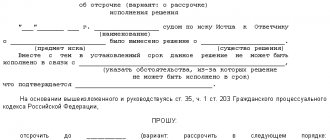Warning in administrative law
The legislation of the Russian Federation is aimed at preventing all types of offenses.
The main goal of all types of administrative measures is to reduce their number. The preventive measures used are aimed at both offenders and persons who may become them. What is a warning? First of all, a warning is an administrative penalty. Article 3.3. The Code classifies it as one of the main types of punishment. It cannot be used as an additional one. In the rank of administrative measures, this is the mildest punishment. Its consequences for the punished are minimal. Features of a warning as a type of punishment:
- warning is a type of liability that applies to both individuals and legal entities;
- the content of the warning is official censure;
- An administrative warning cannot be applied when the offense has signs of high social danger and is committed repeatedly;
- A warning is used only as a primary punishment.
Conditions under which, by virtue of Art. 4.1.1 Code of Administrative Offenses of the Russian Federation, it is possible to replace a fine with a warning
A long time ago, in July 2021, amendments to the Code of Administrative Offenses of the Russian Federation came into force, allowing law enforcement officers to replace punishment in the form of a fine with a warning, subject to certain conditions, for certain categories of offenders. The innovations concern Article 4.1.1 of the Code of Administrative Offenses of the Russian Federation.
A warning is the least significant penalty contained in the Code of Administrative Offenses of the Russian Federation. This punishment is expressed in written censure of the offender, i.e. he does not suffer any material losses.
There are a total of 5 conditions for changing the punishment, and all of them must be met in total.
We present them below.
- The offense must be committed for the first time.
- Violations must be detected during inspection activities carried out by government agencies.
- The involved legal entity must be a small (or medium) business.
- The sanction of the article (under which the culprit is punished) should not contain a penalty in the form of a warning.
- The offense should not cause harm to the life (health) of people, property, the environment, cultural sites, state security, and should not create a threat to an emergency situation.
Important! The rule on the possibility of replacing a fine with a warning also applies to employees of organizations - small and medium-sized businesses that have committed offenses (subject to the conditions stated above).
Issue form
A warning as a type of administrative punishment is always issued in writing. Citizens often confuse verbal comments from law enforcement officers or supervisory authorities with the imposition of real penalties.
Is a verbal warning an administrative penalty? Of course not. A verbal reprimand will not be a punishment. Indeed, officials can release the offender from liability and limit themselves to conversation. They are authorized to classify the offense as minor.
The logical question is: in what form is a warning issued? A protocol on an administrative offense is not drawn up. The violator is given a second copy of the decision against signature. If there is a third party, a copy is made for them. Copies can also be sent by registered mail within three days from the date of the decision.
Conditional administrative warnings are divided into the following types:
- a general warning, which states public rejection of the violation and calls for compliance with the law in the future (a protocol is issued indicating the content of the violation);
- a special warning with the use of measures limiting a repeat offense (for example, a weapon, equipment, or special means with which the violation was committed is confiscated from a citizen or organization).
Issuing a verbal warning
If a verbal warning is warranted, it rarely becomes a formal disciplinary procedure and is sufficient to achieve the desired outcome. As in any situation, before issuing a warning, the manager and all stakeholders must act fairly and give the employee an opportunity to explain his or her view of the situation.
Typically, a verbal warning is given in the presence of witnesses, which has two effects. The first is that there is someone to confirm the remark made, and the second is prevention for the rest of the subordinates.
When issuing a verbal warning, the manager must make sure that the employee understands: – why it was issued; – what actions are required to correct the situation; – future consequences if the warning is not taken into account.
As an example, consider the following text. “Anatoly, as you know, Igor told me that you swore at him during a tea party today in the dining room (Both sides are identified, the nature and date, time and place of the crime committed are indicated.) I heard your vision of this story, and I heard Igor’s opinion. It’s great that you were able to admit your mistake and apologize. However, such behavior is contrary to the company's disciplinary code. I now give you a verbal warning in the presence of your colleagues and remind you that cursing your colleagues for any reason is unacceptable and will not be tolerated. You are warned not to use obscene or offensive language towards any person in this company. (This tells the culprit what he must do to correct the situation.)
The warning is valid for 3 months (this indicates how much time is given to correct the issue), and if you do not take this warning into account, more severe disciplinary methods will be applied. (This shows what will happen if the incident happens again.) How did you understand what I meant by warning and what will happen if you do not correct the behavior?” (This ensures there is no misunderstanding on the part of the culprit.)
After issuing a warning, the manager should record in his diary or other suitable place where the information will be retained for future reference that the warning was issued, the date and time, the reason for it, and the expiration date.
There is no point in posting information about a verbal warning in your personal file, since the offense is not that important and is resolved within the team. If there is no relapse of similar behavior during the probationary period, notes made by the manager in his diary may be deleted.
If a verbal warning was issued and the situation has not changed, then it is time to take more drastic steps and begin preparing a written warning.
Measures
The administrative warning measures that the police can use look completely different. They are not a punishment, but a measure of administrative coercion. Used for the following purposes:
- directly to prevent crime;
- to limit circumstances that threaten the public and personal safety of citizens.
Administrative warning measures are restrictions of an administrative and legal nature, administrative and compulsory actions against a citizen or official.
The first group of measures is used to prevent immediate threats or undesirable consequences for people and society. For example, closing streets or sections of the road where accidents occurred, landslides, or downed power lines.
The second group of measures applies to citizens with antisocial behavior. An example is maintaining administrative supervision over those released from prison.
Authorized persons
Only specially authorized officials can use administrative penalties in their work. Their circle is clearly defined by the Code of Administrative Offenses of the Russian Federation. This list includes:
- commissions on juvenile affairs;
- tax authorities and tax police authorities;
- internal affairs bodies;
- customs and export control authorities;
- border guard agencies and troops;
- state labor inspectorates;
- bodies of State Epidemiological Surveillance, fisheries protection, state environmental control;
- state supervision authorities, transport inspection;
- FAS, Rospotrebnadzor, state housing inspection bodies and many others.
In total, more than 60 bodies and officials can initiate the issuance of an administrative warning.
Reasons for use
In what cases is an administrative warning established:
- a citizen or legal entity commits an offense for the first time;
- the offense did not lead to harm to the life and health of people, objects of the surrounding flora and fauna, or cultural heritage;
- there is no threat of emergency situations, nothing threatens the security of the state;
- there is no property or material damage.
Consequently, a warning as a type of administrative punishment is issued only for minor offenses.
Article 3.4. Warning
Ruling of the Supreme Court of the Russian Federation dated January 11, 2019 N 307-AD18-22865 in case N A56-113745/2017 Taking into account the interrelated provisions of Part 2 of Article 3.4 and Part 1 of Article 4.1.1 of the Code of the Russian Federation on Administrative Offenses, the possibility of replacing punishment in the form of an administrative fine a warning is permitted if there is a combination of all the circumstances specified in Part 2 of Article 3.4 of the said Code. In the case under consideration, the specified set of circumstances, including the absence of a threat of harm to human life and health, was not established by the courts.
Ruling of the Supreme Court of the Russian Federation dated 02/01/2019 N 301-AD18-24398 in case N A79-269/2018
Taking into account the interrelated provisions of Part 2 of Article 3.4 and Part 1 of Article 4.1.1 of the Code of Administrative Offenses of the Russian Federation, the possibility of replacing punishment in the form of an administrative fine with a warning is allowed in the presence of the totality of all the circumstances specified in Part 2 of Article 3.4 of the said Code. In the case under consideration, such a set of circumstances does not exist.
Resolution of the Supreme Court of the Russian Federation dated January 15, 2019 N 7-AD18-5
Taking into account the interrelated provisions of Part 2 of Article 3.4 and Part 1 of Article 4.1.1 of the Code of Administrative Offenses of the Russian Federation, the possibility of replacing punishment in the form of an administrative fine with a warning is allowed in the presence of the totality of all the circumstances specified in Part 2 of Article 3.4 of the said Code. Contrary to the arguments of the complaint, in the case under consideration there is no such set of circumstances, as is reasonably indicated in the appealed judicial acts.
Determination of the Constitutional Court of the Russian Federation dated February 28, 2019 N 285-O
As part of the implementation of state policy in the field of control and supervisory activities, the legislator was not deprived of the opportunity to establish special conditions for the application of administrative liability, which ensure differentiation of the conditions of administrative liability of small and medium-sized businesses in order to prevent excessive administrative coercion in relation to these entities, which is reflected in the contested regulation (part 3 of article 3.4, article 4.1.1 of the Code of Administrative Offenses of the Russian Federation).
Ruling of the Supreme Court of the Russian Federation dated April 10, 2019 N 305-ES19-555 in case N A41-67608/2018
Contrary to the arguments of the complaint, the totality of all circumstances, taking into account the interrelated provisions of Part 2 of Article 3.4 and Part 1 of Article 4.1.1 of the Code of the Russian Federation on Administrative Offenses, has not been established to replace the punishment in the form of an administrative fine with a warning. Other arguments of the complaint were the subject of consideration by the courts and they were given an exhaustive legal assessment in the appealed judicial acts, with which there is no reason to disagree.
Determination of the Constitutional Court of the Russian Federation dated May 29, 2019 N 1448-O
Thus, Articles 3.4 and 4.1.1 of the Code of Administrative Offenses of the Russian Federation, acting in conjunction, determine the conditions under which, in the case of bringing these persons to administrative responsibility, an administrative penalty in the form of an administrative fine must be replaced with a warning. At the same time, the application of these norms is carried out based on the factual circumstances of each case by the judge, body, official who is considering this case, including the case of an administrative offense provided for in Part 1 of Article 20.8 of the said Code.
Ruling of the Supreme Court of the Russian Federation dated July 5, 2019 N 310-ES19-10517 in case N A23-5552/2018
In accordance with Part 1 of Article 4.1.1 of the Code of Administrative Offenses of the Russian Federation, a warning as a measure of administrative punishment in cases where it is not provided for in the corresponding article of Section II of this Code is assigned instead of an administrative fine in the presence of a set of circumstances established by Part 2 of Article 3.4 of the Code of Administrative Offenses of the Russian Federation. In general, the issue of reducing sanctions is related to the assessment of evidence in the case, which is within the competence of the courts of first and appellate instances.
Ruling of the Supreme Court of the Russian Federation dated July 16, 2019 N 305-ES19-11098 in case N A40-207068/2018
At the same time, the courts came to the conclusion that in the case under consideration there was no necessary set of circumstances, provided for in Part 2 of Article 3.4 of the Code of Administrative Offenses of the Russian Federation, to replace the prescribed punishment in the form of a fine with a warning. There are no grounds for other conclusions based on the arguments of the complaint.
Ruling of the Supreme Court of the Russian Federation dated July 16, 2019 N 305-ES19-11104 in case N A40-207065/2018
At the same time, the courts came to the conclusion that in the case under consideration there was no necessary set of circumstances, provided for in Part 2 of Article 3.4 of the Code of Administrative Offenses of the Russian Federation, to replace the prescribed punishment in the form of a fine with a warning. There are no grounds for other conclusions based on the arguments of the complaint.
Ruling of the Supreme Court of the Russian Federation dated July 16, 2019 N 305-ES19-11641 in case N A40-207062/2018
At the same time, the courts came to the conclusion that in the case under consideration there was no necessary set of circumstances, provided for in Part 2 of Article 3.4 of the Code of Administrative Offenses of the Russian Federation, to replace the prescribed punishment in the form of a fine with a warning. There are no grounds for other conclusions based on the arguments of the complaint.
Resolution of the Supreme Court of the Russian Federation dated June 17, 2019 N 44-AD19-4
In the case under consideration, it does not follow from the materials of the case on an administrative offense that the conditions provided for in Part 2 of Article 3.4 of the Code of the Russian Federation on Administrative Offenses exist. The resolution to bring the company to administrative liability was made in compliance with the statute of limitations for bringing to administrative liability established by Part 1 of Article 4.5 of the Code of the Russian Federation on Administrative Offenses for this category of cases.
When administrative measures can be applied
Let us remind you that an administrative warning can be applied to both individuals and legal entities.
If the decision on an administrative warning has entered into force, the person is considered subject to administrative punishment. In some exceptional cases, administrative measures may be applied to the violator. They are usually aimed at ensuring the execution of administrative punishment. This could be an inspection of things and goods, document verification, removal from driving, driving, and others.
How to get a warning instead of a fine in 2021?
Everything is very simple. Based on the situations described above, you need to either apply for an administrative warning on the road to the inspector, or, if the decision has already been issued, file a complaint with a higher official or with the court for a mitigation of the punishment.
In the first case, the petition is written in free form. But there is an important subtlety: you need to have time to write it before the traffic police officer writes the resolution. Therefore, it is better to print out such paper in advance and carry it with you.
In the case of challenging a fine, not a petition is filed, but a complaint. It is also written in free form, and in it you ask to replace the fine with a warning.
Something else useful for you:
- How to appeal (challenge) a traffic police fine?
- What are the fines for driving without paying on a toll road? New law on non-payment of toll sections
- Suspension from driving a vehicle in questions and answers
Sample petition to a traffic police officer or to the court
In the sample petition to the traffic police inspector, you write to whom and from whom you are submitting it, the essence of the appeal, and at the bottom you put a date and signature. In essence, you need to indicate approximately the following:
Based on Articles 3.4, 4.2 and 4.4 of the Code of Administrative Offenses of the Russian Federation, I ask you to apply the minimum sanction of the norm (assign a warning) provided for in Article __, Part __ of the Code of Administrative Offenses, due to the absence of aggravating and the presence of mitigating circumstances in the form of such and such.
- by a traffic police officer (DOCX format for filling out and further printing).
- (for printing and further filling out by hand).
If the traffic police have already issued a fine against you, then you need to challenge it. We described the procedure and deadlines in as much detail as possible in a special article about appealing. Here we provide separate examples of complaints.
- (DOCX format).
- .










